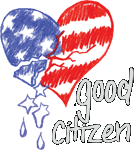“Good Citizen” Contest
The information here is designed to provide ideas for putting on a “Good Citizen or Citizenship Award Contest” for students in grades K – 5.
The goals of such a contest are to:
- make students aware that they are citizens of a country and that citizens in a democracy have a critical role in ensuring the country stays free and safe.
- help students understand the types of actions required of them to be effective citizens and that citizenship goes well beyond voting, jury duty and community service.
- give students the belief that individual actions make a difference and that being a good citizen can be fun and rewarding.
The competition is also designed to give students the opportunity to develop their critical thinking and presentation skills.

